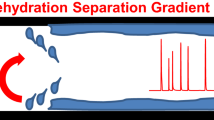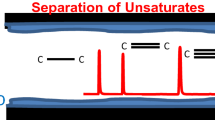Abstract
An acidic water stationary phase is used for the analysis of carboxylic acids in capillary gas chromatography (GC). Under regular pH 7 operating conditions, these analytes are largely ionized and elute poorly, if at all, from the water phase. However, by adjusting the phase to pH 2, it is found that various acids are neutralized and can be readily eluted and separated in the system. Sulfamic acid is found to provide a stable pH for the water phase over time, whereas hydrochloric acid and other more volatile additives quickly evaporate from the column. Under optimal low pH conditions, the acidic analytes yield good peak shape and are readily observed for masses investigated down to 5 ng on-column. By comparison, on a conventional non-polar capillary GC column, the same analytes display threefold more peak tailing and are not detected for masses below 30 ng on-column. Through altering the phase pH, it is found that the selectivity between certain analytes can be potentially enhanced depending on their respective pKa values and/or ionizability. The analysis of various different samples containing carboxylic acids is demonstrated and the results indicate that this approach can possibly offer unique and beneficial selectivity in such determinations.








Similar content being viewed by others
References
Cazes J (2005) Ewing’s analytical instrumentation handbook. Marcel Dekker, New York
Venn RF (2008) In: Venn RF (ed) Principles and practice of bioanalysis, 2nd edn. CRC Press/Taylor & Francis Group, Boca Raton
Santos FJ, Galceran MT (2003) Modern developments in gas chromatography-mass spectrometry-based environmental analysis. J Chromatogr A 1000:125–151
James AT, Martin AJP (1952) Gas–liquid partition chromatography: the separation and micro-extraction of volatile fatty acids from formic acid to dodecanoic acid. J Biochem 50:679–690
Liska I, Slobodnik J (1996) Comparison of gas and liquid chromatography for analyzing polar pesticides in water samples. J Chromatogr A 733:235–258
Kidwell DA, Kidwell JD, Shinohara F, Harper C, Roarty K, Bernadt K, McCaulley RA, Smith FP (2003) Comparison of daily urine, sweat, and skin swabs among cocaine users. Forensic Sci Int 133:63–78
Conway JM, Birnbaum AK, Marino SE, Cloyd JC, Remmel RP (2012) A sensitive capillary GC-MS method for analysis of topiramate from plasma obtained from single-dose studies. Biomed J Chromatogr A 26:1071–1076
Scott SA, Douglas GS, Uhler AD, McCarthy KJ, Emsbo-Mattingly SD (2005) Identifying the source of mystery waterborne oil spills—a case for quantitative chemical fingerprinting. J Environ Claim 17:71–88
Li QL, Poole CF (2001) Selectivity equivalence of poly (dimethyldiphenylsiloxane) stationary phases for open-tubular column gas chromatography. J Sep Sci 24:129–135
Poole CF, Li QL, Kiridena W, Koziol WW (2001) Selectivity assessment of popular stationary phases for open-tubular column gas chromatography. J Chromatogr A 912:107–117
Alvarez JG, Gomis DB, Abrodo PA, Llorente DD, Busto E, Lombardia NR, Fernandez VG, Alvarez MDG (2011) Evaluation of new ionic liquids as high stability selective stationary phases in gas chromatography. Anal Bioanal Chem 400:1209–1216
Shashkov MV, Sidel’nikov VN (2015) Thermostable columns based on ionic liquids for the analysis of hydrocarbon mixtures by two-dimensional chromatography. Prot Met Phys Chem 51:1080–1086
Mendoza LG, Gonzalez-Alvarez J, Gonzalo CF, Arias-Abrodo P, Altava B, Luis SV, Burguete MI, Gutierrez-Alvarez MD (2015) Gas chromatographic analysis of fatty acid methyl esters of milk fat by an ionic liquid derived from l-phenylalanine as the stationary phase. Talanta 143:212–218
Kulsing C, Nolvachai Y, Hugel HM, Marriott PJ (2015) Developments in gas chromatography using ionic liquid stationary phases. LC GC Eur 28:434–440
Srivastava M, Roy PK, Ramanan A (2016) Hydrolytically stable ZIF-8@PDMS core-shell microspheres for gas-solid chromatographic separation. Rsc Adv 6:13426–13432
Yusuf K, Aqel A, Othman ZAL (2014) Metal-organic frameworks in chromatography. J Chromatogr A 1348:1–16
Sun T, Tian L, Li JM, Qi ML, Fu RN, Huang XB (2013) Dithienyl benzothiadiazole derivatives: a new type of stationary phases for capillary gas chromatography. J Chromatogr A 1321:109–118
Gallant JA, Thurbide KB (2014) Properties of water as a novel stationary phase in capillary gas chromatography. J Chromatogr A 1359:247–254
Darko E, Thurbide KB (2016) Capillary gas chromatographic separation of organic bases using a pH-adjusted basic water stationary phase. J Chromatogr A 1465:184–189
Yang MH, Choong YM (2001) A rapid gas chromatographic method for direct determination of short-chain (C2–C12) volatile organic acids in foods. Food Chem 75:101–108
Jurado-Sanchez B, Ballesteros E, Gallego M (2011) Gas chromatographic determination of 29 organic acids in foodstuffs after continuous solid-phase extraction. Talanta 84:924–930
Mato I, Suarez-Luque S, Huidobro JF (2005) A review of the analytical methods to determine organic acids in grape juices and wines. Food Res Int 38:1175–1188
Zuo-gang G, Shu-rong W, Ying-ying Z, Zhong-yang L, Ke-fa C (2009) Separation of acid compounds for refining biomass pyrolysis oil. J Fuel Chem Technol 37:49–52
Gutierrez-Villagomez JM, Vazquez-Martinez J, Ramirez-Chavez E, Molina-Torres J, Trudeau VL (2017) Analysis of naphthenic acid mixtures as pentafluorobenzyl derivatives by gas chromatography–electron impact mass spectrometry. Talanta 162:440–452
Jurado-Sanchez B, Ballesteros E, Gallego M (2010) Determination of carboxylic acids in water by gas chromatography using several detectors after flow preconcentration. J Chromatogr A 1217:7440–7447
Jurado-Sanchez B, Ballesteros E, Gallego M (2012) Determination of carboxylic acids in water by gas chromatography–mass spectrometry after continuous extraction and derivatization. Talanta 93:224–232
Kawamura K, Ng LL, Kaplan IR (1985) Determination of organic-acids (C1–C10) in the atmosphere, motor exhausts, and engine oils. Environ Sci Technol 19:1082–1086
Khasanov VV, Makarycheva AI, Slizhov YG (2016) Determination of aliphatic acids in natural waters using distillation and solid-phase extraction. J Anal Chem 71:1028–1032
Hallmann C, van Aarssen BGK, Grice K (2008) Relative efficiency of free fatty acid butyl esterification choice of catalyst and derivatisation procedure. J Chromatogr A 1198:14–20
Ford QL, Burns JM, Ferry JL (2007) Aqueous in situ derivatization of carboxylic acids by an ionic carbodiimide and 2,2,2-trifluoroethylamine for electron-capture detection. J Chromatogr A 1145:241–245
Yalkowsky SH, He Y (2003) Handbook of aqueous solubility data. CRC Press, Boca Raton
Fuchs B, Suss R, Teuber K, Eibisch M, Schiller J (2011) Lipid analysis by thin-layer chromatography—a review of the current state. J Chromatogr A 1218:2754–2774
Pinu FR, de Carvalho-Silva S, Uetanabaro APT, Villas-Boas SG (2016) Vinegar metabolomics: an explorative study of commercial balsamic vinegars using gas chromatography-mass spectrometry. Metabolites 6:1–15
Brittain HG (1999) In: Brittain HG (ed) Analytical profiles of drug substances and excipients, 1st edn. Academic Press, Millbrae
Sebok A, Vasanits-Zsigrai A, Palko G, Zaray G, Molnar-Perl I (2008) Identification and quantification of ibuprofen, naproxen, ketoprofen and diclofenac present in waste-waters, as their trimethylsilyl derivatives, by gas chromatography mass spectrometry. Talanta 76:642–650
Ortiz X, Jobst KJ, Reiner EJ, Backus SM, Peru KM, McMartin DW, O’Sullivan G, Taguchi VY, Headley JV (2014) Characterization of naphthenic acids by gas chromatography–Fourier transform ion cyclotron resonance mass spectrometry. Anal Chem 86:7666–7673
Acknowledgements
The authors are grateful to the Natural Sciences and Engineering Research Council of Canada (NSERC) for a Discovery Grant in support of this project.
Author information
Authors and Affiliations
Corresponding author
Ethics declarations
Funding
This study was funded by an NSERC Discovery Grant.
Conflict of interest
The authors declare no conflict of interest.
Ethical approval
This study does not involve any human or animal participants.
Rights and permissions
About this article
Cite this article
Darko, E., Thurbide, K.B. Capillary Gas Chromatographic Separation of Carboxylic Acids Using an Acidic Water Stationary Phase. Chromatographia 80, 1225–1232 (2017). https://doi.org/10.1007/s10337-017-3333-z
Received:
Accepted:
Published:
Issue Date:
DOI: https://doi.org/10.1007/s10337-017-3333-z




